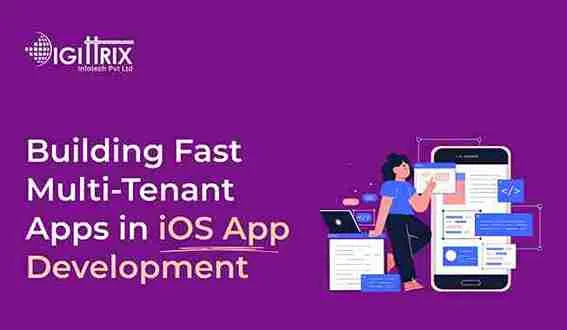Multi-tenant apps efficiently serve multiple users while maintaining data security, enhancing scalability, performance, and overall experience for businesses and their clients across platforms.
Highlights
An enthusiastic developer and skilled business management expert with over a decade of experience in the field

In the modern digital age, multi-tenant applications have become vital for businesses that serve multiple clients on a single platform. Multi-tenant app development enables different organizations or users to access a shared software instance while keeping their data private. This method is highly efficient and cost-effective, especially when compared to deploying separate instances for each client. However, creating multi-tenant apps presents its own challenges, especially regarding performance, security, and scalability. In this article, we will explore how to build multi-tenant apps without sacrificing performance, while following best practices for mobile app development.
Planning a new venture? Check out Digittrix’s insights on why startups are choosing multi-tenant platforms in 2025 to scale smarter!
At its core, a multi-tenant application is built to serve multiple customers with a single software instance. Each tenant operates in an isolated environment, which guarantees their data stays private. Multi-tenant architecture can differ based on how resources are shared.
Understanding the correct architecture is essential during multi-tenant app development because it directly impacts app performance and user satisfaction.
Building multi-tenant applications comes with its hurdles. Some common challenges include:
Understanding these challenges is the first step toward creating an app that balances performance and functionality.
Choosing the right database strategy is essential. For smaller applications with many tenants, using a shared database with separate schemas is often effective. For larger clients with extensive data needs, a separate database for each tenant is better. Indexing, query optimization, and caching strategies also are crucial for maintaining performance.
Using efficient data access layers decreases the load on the server. Data queries should be optimized to retrieve only necessary information. Employing techniques like pagination and lazy loading helps control memory usage and response times, which are essential in mobile app development where high performance is expected.
Caching frequently accessed data decreases server load and enhances response times. For instance, tenant-specific configuration or static resources can be stored in memory or a distributed cache. This guarantees quicker access for end-users while reducing database queries.
Heavy computations or data-heavy tasks should be processed asynchronously. Background processing frameworks enable jobs to run without impacting the main application's performance. Tasks like report generation, data synchronization, or batch processing can be managed this way, keeping the app responsive.
Horizontal scaling involves adding more servers to handle increased demand, while vertical scaling upgrades the resources of the existing server. Often, a combination of both is necessary for multi-tenant applications to maintain steady performance as user numbers grow.
Performance monitoring tools help spot bottlenecks in real-time. Tracking metrics like response times, query execution, and server load enables developers to fix performance issues before they impact tenants. Regular audits of system performance are a vital part of multi-tenant app development.
API throttling and rate limiting prevent any single tenant from overloading the system. By limiting the number of requests a tenant can make within a set period, the app ensures stability and fair usage for all tenants.
When it comes to mobile app development for multi-tenant applications, performance and usability are essential. Mobile users expect quick, responsive apps, and a poorly functioning one can result in user churn. Here are some key considerations:
Reduce the amount of data transmitted over the network. Use efficient data formats like JSON or Protocol Buffers and compress data whenever possible. This decreases load times and provides a smoother experience for mobile users.
Mobile users may not always have a reliable internet connection. Adding offline support, where users can keep working and sync data later, enhances usability and customer satisfaction.
Mobile apps should adapt to various screen sizes and orientations. A responsive design guarantees that all users experience consistency and smoothness across different devices.
Mobile devices have limited resources compared to desktops. Optimizing memory use, managing background tasks, and reducing battery drain are essential for mobile app development in multi-tenant applications.
Custom app development offers the flexibility to meet specific business needs while ensuring high performance. Different from ready-made solutions, custom apps enable businesses to create workflows and features tailored to tenant needs. Here are some steps to ensure successful custom app development:
Conducting a thorough analysis of tenant needs helps prioritize features and optimize the app architecture for better performance.
A modular approach enables separate development and deployment of individual features. This decreases the likelihood of performance problems and simplifies system maintenance as it expands.
Custom apps enable developers to implement strict security protocols, such as encryption and multi-factor authentication, to safeguard tenant data. Security measures should be integrated into the development process from day one.
Regular testing is essential for detecting performance bottlenecks, bugs, and vulnerabilities. Automated testing across multiple tenants guarantees consistent performance and reliability.
A custom app can be updated regularly to improve performance, fix tenant-specific issues, and add new features without impacting other tenants. This flexibility is a major benefit of custom app development.
Choosing the right app development company can greatly influence the success of a multi-tenant application. Experienced firms bring expertise in mobile app development, on-demand app creation, and multi-tenant solutions. Here are some factors to consider:
Review the company’s past projects to determine if they have experience building multi-tenant systems and managing complex data needs.
Ensure the team has expertise in databases, cloud services, and performance optimization techniques related to multi-tenant apps.
Effective communication guarantees clear understanding and proper implementation of requirements. Post-launch support is just as crucial for managing performance issues and updates.
Some app development companies provide full services, including UI/UX design, development, deployment, and maintenance. Picking a provider that manages everything simplifies project management.
Performance testing is essential in multi-tenant app development. Without proper testing, an app might fail under load, leading to poor user experiences. Some key practices include:
Simulate high traffic scenarios to verify the system's ability to support multiple tenants at once. Load testing helps identify bottlenecks before they affect users.
Test the application under extreme conditions to assess its stability and recovery capabilities. Stress testing helps developers prepare for unexpected increases in usage.
Indexes, query optimization, and caching strategies enhance data retrieval speed. Efficient database design directly influences app responsiveness.
Implement monitoring tools to track server performance, memory usage, and database queries. Real-time insights help maintain consistent performance across tenants.
Review the code regularly to eliminate redundancies, optimize algorithms, and decrease resource usage. Clean, efficient code enhances overall app performance.
Many businesses now favor on-demand app development for multi-tenant solutions. On-demand apps offer services like ride-sharing, food delivery, and task management to multiple clients at once. Adding on-demand features to a multi-tenant platform needs careful planning.
On-demand apps depend on real-time notifications and updates. Improving server performance guarantees tenants get timely information without delays.
Scheduling algorithms should be optimized for multiple tenants. For example, ride-sharing apps must manage numerous bookings while maintaining low response times.
Multi-tenant on-demand apps need secure and reliable payment solutions. Using scalable payment systems ensures seamless transactions across tenants.
The backend should support rapid scaling to manage fluctuating demand. Cloud-based solutions provide the flexibility to increase resources during peak periods.
Planning to develop a payment app? Check out Digittrix’s comprehensive guide on building secure and user-friendly payment apps to get started!
Building multi-tenant applications without sacrificing performance demands careful planning, efficient architecture, and ongoing optimization. From choosing the right database approach to monitoring system performance, every development aspect must prioritize responsiveness and security for multiple tenants. Mobile app development considerations like lightweight data transfer, offline support, and responsive design are also crucial to ensure a smooth experience for end-users.
Custom app development provides the flexibility to meet specific tenant needs while ensuring high performance. Working with an experienced app development company can simplify the process and bring expertise in multi-tenant app creation.
By following these guidelines, businesses can create multi-tenant applications that efficiently serve multiple clients, deliver reliable performance, and adapt to the changing needs of modern users. Investing time in planning, testing, and optimization ensures that your multi-tenant system remains strong, responsive, and scalable as your business grows.
As the startup ecosystem keeps evolving, building a multi-tenant app has become crucial for scaling efficiently and managing multiple clients on one platform. Multi-tenant applications provide a cost-effective way to optimize operations, ensure security, and deliver performance without needing complex infrastructure.
At Digittrix, we specialize in helping startups develop multi-tenant apps with confidence. With over 14 years of experience and a team of skilled developers, we offer comprehensive multi-tenant app development and migration services. Whether you need custom app development, mobile app development, or cloud-based integration, we provide solutions that are secure, scalable, and user-friendly.
If you’re ready to build a multi-tenant app that supports growth and efficiency, our team is here to guide you every step of the way. Call us at +91 8727000867 to discuss your requirements and technical goals.
Got questions or want more info? Email us at digittrix@gmail.com. Let Digittrix show you how building a multi-tenant app can help your startup succeed in 2025.

Do you need help in Mobile App development?




Join over 1500+ businesses we've already helped!
A multi-tenant app enables multiple users or organizations to share the same software instance while maintaining their data separately.
Good performance ensures everyone can access the system smoothly without delays, even during peak usage.
Optimized mobile design with quick loading, offline support, and clear layouts enhances usability for all users.
Security measures such as data isolation, encryption, and controlled access safeguard each user's sensitive information.
Regular updates enhance functionality, fix bugs, and preserve performance without disrupting users.

©2025Digittrix Infotech Private Limited , All rights reserved.